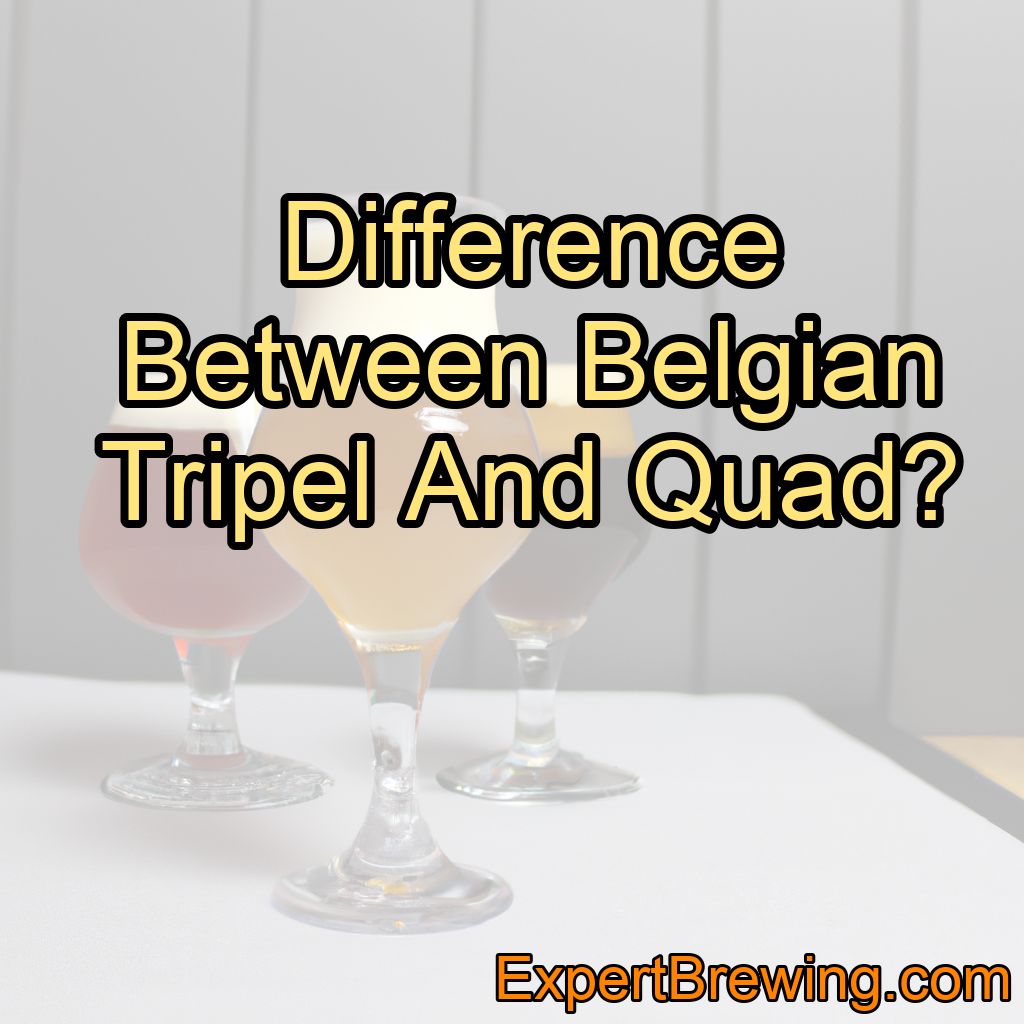As someone who has spent a considerable amount of time brewing and enjoying various styles of beer, I have developed a deep appreciation for the rich history and tradition associated with Belgian ales. Two styles that often spark curiosity and debate among beer enthusiasts are the Belgian Tripel and the Belgian Quadrupel (or “Quad” for short).
The main difference between a Belgian Tripel and a Quad lies in their alcohol content, flavor profiles, and appearance. Tripels are typically lighter in color and have a higher carbonation, while Quads are darker, richer, and heavier in body.
In this post, I’ll dive into the nuances and characteristics that set these two beer styles apart, and share some of my personal experiences and insights as a brewer. With that, let’s explore the world of Belgian Tripels and Quads.
1. Historical Origins
Belgian Tripel
The Belgian Tripel has its roots in Trappist monasteries, where monks have been brewing beer for centuries. The name “Tripel” is thought to have originated from the brewing process, where brewers used up to three times the amount of malt compared to a standard Trappist beer.
Belgian Quad
The Belgian Quad, like the Tripel, also has its origins in Trappist brewing. The term “Quadrupel” is actually a trademark of the La Trappe brewery in the Netherlands, which first produced this style of beer in 1991. The name “Quad” is believed to have been coined in reference to its higher alcohol content and richness compared to its lighter counterparts.
2. Alcohol Content
When it comes to alcohol content, Belgian Tripels and Quads are both on the higher end of the scale.
Belgian Tripel
Tripels typically have an alcohol content ranging from 8% to 12% ABV. This high alcohol content is often masked by the beer’s fruity and spicy flavors, making it dangerously easy to drink.
Belgian Quad
Quads are even stronger than Tripels, with alcohol contents usually ranging from 10% to 14% ABV. This high alcohol content contributes to the beer’s warming sensation and rich, complex flavor profile.
3. Flavor Profiles
Belgian Tripel
Tripels are known for their fruity and spicy flavors, with notes of banana, pear, and sometimes citrus fruits. These flavors are derived from the unique Belgian yeast strains used in brewing, which produce esters and phenols that contribute to the beer’s distinctive taste. Tripels often have a subtle sweetness, balanced by a moderate hop bitterness and a dry finish.
Belgian Quad
Quads are characterized by their rich, complex flavors, often featuring notes of dark fruit (such as raisins, plums, and figs), caramel, and molasses. They also exhibit some spiciness from the Belgian yeast, but this is typically more subdued than in a Tripel. The high alcohol content in Quads can also contribute to a warming sensation on the palate.
4. Appearance
Belgian Tripel
Tripels are usually pale to deep gold in color, with a dense, creamy head that lingers throughout the drinking experience. The beer is often highly carbonated, lending to its effervescent appearance.
Belgian Quad
In contrast, Quads are deep amber to dark brown in color, with a dense, tan head. They are less carbonated than Tripels, giving them a heavier, more viscous appearance.
5. Mouthfeel
Belgian Tripel
Tripels have a medium to full body but are highly carbonated, which helps to create a lighter, more effervescent mouthfeel. This higher carbonation also helps to cleanse the palate, preventing the beer from becoming too heavy or cloying.
Belgian Quad
Quads have a fuller body and a lower carbonation than Tripels, resulting in a richer, more viscous mouthfeel. This heavier body helps to carry the complex flavors of the beer and contributes to its warming sensation.
6. Brewing Process
While the brewing process for Belgian Tripels and Quads is similar, there are some key differences in ingredients and techniques that contribute to the distinct characteristics of each style.
Belgian Tripel
Tripels are brewed with a high proportion of Pilsner malt, which contributes to their light color and subtle sweetness. They also often include the addition of sugar, which boosts the alcohol content without adding body or residual sweetness. This helps to create a beer that is both strong and highly drinkable.
Belgian Quad
Quads, on the other hand, are brewed with a more diverse range of malts, including darker and more flavorful varieties that contribute to the beer’s rich color and flavor profile. They may also include the addition of sugar, but in smaller quantities compared to Tripels. This results in a beer that is both strong and full-bodied.
7. Food Pairings
Both Belgian Tripels and Quads are highly versatile when it comes to food pairings, but their distinct characteristics lend themselves to different types of dishes.
Belgian Tripel
Tripels pair well with a wide range of dishes, from light salads and seafood to richer, spiced dishes like Thai curry or Mexican mole. The beer’s high carbonation and dry finish help to cleanse the palate between bites, making it an excellent companion to a variety of flavors and textures.
Belgian Quad
Quads are best suited to richer, more robust dishes, such as braised meats, game, and strong cheeses. Their complex flavor profile and full body can stand up to bold, hearty flavors, while their warming sensation makes them an ideal choice for colder weather fare.
8. Serving Temperature
When it comes to serving temperature, both Belgian Tripels and Quads are best enjoyed at a slightly warmer temperature than most other beer styles.
Belgian Tripel
Tripels should be served at a temperature of around 45-50°F (7-10°C). This allows the beer’s fruity and spicy flavors to shine, without being overwhelmed by the alcohol content.
Belgian Quad
Quads should be served slightly warmer, at a temperature of around 50-55°F (10-13°C). This helps to bring out the beer’s rich flavors and enhances its warming sensation on the palate.
9. Aging Potential
Both Belgian Tripels and Quads have the potential to age well, developing new flavors and characteristics over time.
Belgian Tripel
While Tripels can be enjoyed fresh, they also have the potential to age gracefully for several years. As they age, their fruity and spicy flavors can mellow, giving way to more complex, vinous notes.
Belgian Quad
Quads are particularly well-suited to aging, with their high alcohol content and complex flavors becoming even richer and more nuanced over time. Some Quads can be aged for a decade or more, developing sherry-like characteristics and an even greater depth of flavor.
Conclusion
In conclusion, the main differences between Belgian Tripels and Quads lie in their alcohol content, flavor profiles, and appearance. Tripels are lighter in color, with fruity and spicy flavors and a higher carbonation, while Quads are darker, richer, and heavier in body. To recap, here are ten key facts about these two distinctive beer styles:
1. Both styles have their origins in Trappist brewing.
2. Tripels typically have an alcohol content of 8-12% ABV, while Quads range from 10-14% ABV.
3. Tripels are characterized by fruity and spicy flavors, while Quads feature rich, dark fruit and caramel notes.
4. Tripels are golden in color, while Quads are deep amber to dark brown.
5. Tripels have a lighter, more effervescent mouthfeel, while Quads are heavier and more viscous.
6. Tripels are brewed with a high proportion of Pilsner malt and often include sugar, while Quads use a more diverse range of malts and less sugar.
7. Tripels pair well with a wide variety of dishes, while Quads are best suited to richer, more robust fare.
8. Tripels should be served at 45-50°F (7-10°C), while Quads should be served at 50-55°F (10-13°C).
9. Both styles have aging potential, with Quads being particularly well-suited to long-term aging.
10. Despite their differences, both Belgian Tripels and Quads are revered for their complex flavors and rich history, making them beloved favorites among beer enthusiasts worldwide.
FAQs
What makes a Belgian beer a quad?
A Belgian beer is classified as a quad based on its high alcohol content, typically above 10%, and its complex malt and yeast profile, which results in a rich and full-bodied flavor with notes of dark fruit, caramel, and spice.
What is a Belgian-style quad?
A Belgian-style quad is a strong, dark beer with a high ABV (alcohol by volume) typically brewed with Belgian yeast and characterized by rich, malty flavors and fruity notes.
What does Quad IPA mean?
Quad IPA stands for Quadruple India Pale Ale, a beer style that is known for its high alcohol content and intense hop flavor and aroma. It is a variation of the popular IPA style, but with even more malt and hops added to create a stronger and more robust beer.
Why is it called a Belgian quad?
A Belgian quad is called so because it is a strong, dark ale that originated in Belgian monasteries and is typically brewed with four times the amount of malt as a standard Belgian ale.
What are the levels of IPA?
The levels of IPA refer to the percentage of isopropyl alcohol in a solution. The most common levels of IPA are 70%, 91%, and 99%.
What style of beer is a quad?
A quad is a style of Belgian beer that is typically dark, strong, and complex, with a high alcohol content and flavors of dark fruit, caramel, and spices.




